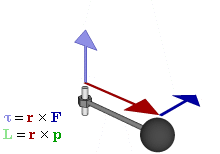Torque
tendency of a force to rotate an object; counterpart of force in rotational systems From Wikipedia, the free encyclopedia
Remove ads
In physics, torque is the tendency of a force to turn or twist. If a force is used to begin to spin an object, or to stop an object from spinning, a torque is made.


The force applied to a lever, multiplied by the distance from the lever's fulcrum, multiplied again by the sine of the angle created, is described as torque. This is also known as "r cross f," or "force times fulcrum distance times sine theta."
Remove ads
Fulcrum
Fulcrum is the axis of rotation or point of support on which a lever turns in raising or moving something.
Equation
The equation for torque is:
where F is the net force vector and r is the vector from the axis of rotation to the point where the force is acting. The Greek letter Tau is used to represent torque.
The units of torque are force multiplied by distance.[1] The SI unit of torque is the newton-metre. The most common English unit is the foot-pound.
Remove ads
Torque with Angled Forces
When the force is applied at an angle, only the part of the force that aligns with the sine theta component of "r cross f" contributes to torque.
The closer the angle is to 90 degrees, the larger the sine theta value, and the greater the torque generated.
Torque In Gears

Angled force affects how much torque actually gets into a gear system. If less torque is created at the start (because the force isn’t at 90 degrees), then the gear has less to work with.
Angled forces reduce gear efficiency because not all of the force goes into turning the gear.
Remove ads
References
Other websites
Wikiwand - on
Seamless Wikipedia browsing. On steroids.
Remove ads

